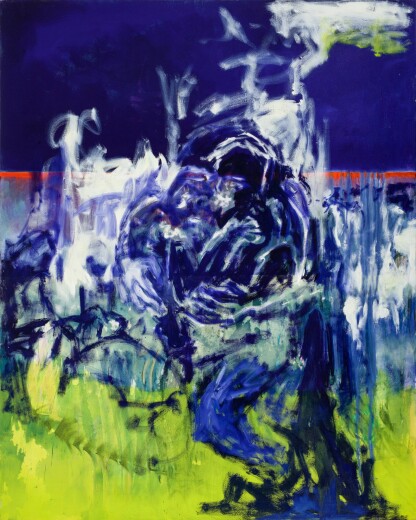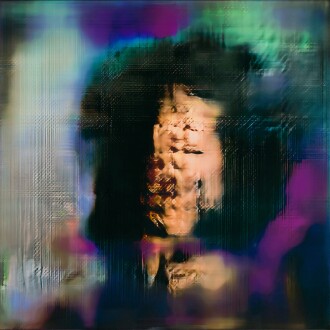T his year, Sotheby’s is hosting a benefit auction for the first ever Norval Sovereign African Art Prize. A collaboration between The Sovereign Art Foundation and Norval Foundation — and sponsored by EON Reality — the prize supports work by artists working on the continent of Africa and celebrates some of the most significant contemporary artists working today.

A board of 53 independent art professionals — consisting of curators and academics who work closely with artists in their respective regions — nominated artists to enter. A total of 336 entries were received from artists from 37 countries. Thirty finalists representing 18 different countries were then shortlisted by a panel of five world-class art specialists: David Elliott, Janine Gaëlle Dieudji, Khanya Mashabela, Marie-Ann Yemsi, and Tim Marlow. And on 15 February, 2022, Bonolo Kavula was announced as the winner of the inaugural prize, a ZAR 500,000 cash award and the opportunity for a solo exhibition at Norval Foundation in Cape Town. Kavula’s work, titled Tswelopele, is an abstract tapestry made from a repurposed shweshwe dress, a traditional South African fabric.
Work by the other twenty-nine finalists is now on view at The Norval Foundation, where they will also be voted on by the public. The shortlisted works excluding the Grand Prize Winner are also offered for auction at Sotheby’s, with all proceeds going to the shortlisted artists and to raise funds for Norval Foundation’s Educational Program in an equal split.
Below, four finalists share their perspective on their work, how collectors can support artists, and the importance of contemporary art in Africa.
Januario Jano
How would you describe contemporary art from Africa in five words or phrases?
Unapologetic, diverse, vibrant, thoughtful, and relevant.
Who are the three living artists you most admire?
Antonio Ole, Esther Mahlangu, and Abdoulaye Konaté.
Who are three historical artists who have impacted your work?
Jean Depara, Albano Neves e Sousa, and Charles White.
What fuels you in your studio?
The need to be connected to my inner core.
What was your favorite group exhibition you have been included in and why?
“Redirecting” at the Tree Art Museum in Beijing last year. It was sort of breaking through the walls of the pandemic. I felt reinvigorated.
What food or drinks pair well with your art?
Funge (an Angolan dish) and a freshwater or non-alcoholic beer.
How can collectors best support artists?
By being honest and genuine with the work they are collecting as well as the artist.
What is an artist’s greatest responsibility?
To be true to their roots and continue to push the narrative through their practice.
Thania Petersen
How would you describe contemporary art from Africa in five words or phrases?
Innovative, sophisticated, important, relevant, critical.
Who are the three living artists you most admire? Who are three historical artists who have impacted your work?
Ooh, it’s like asking what’s your favorite food — it changes with every meal and depends on what my heart desires. I love the work of Frowhawk Two Feathers, Lungiswa Gqunta, and Igshaan Adams.
Historically, it’s difficult to say. Over the years, I have reflected and studied endless miniature Mughal paintings and Islamic textiles made by unnamed artists. I am forever grateful for their contribution to my life.
What fuels you in your studio?
Anger.
What was your favorite group exhibition you have been included in and why?
“Radical Love” at the Ford Foundation in New York. It was incredibly exciting to be a part of such a great show curated by extraordinary women of color.
What food or drinks pair well with your art?
Hertzoggies and twee gevrietjies. They are biscuits often featured in my work.
They were invented by the “Cape-Malay” community to demonstrate their support for the politician J.B.M. Hertzog after he promised to give women the right to vote and to give equal rights to the colored community in the 1920s. After fulfilling the first promise in 1930, but not the second, the community began baking the cookies with a brown and pink icing called twee gevreetjie (Afrikaans for “hypocrite”) to show their dissatisfaction. These cakes continue to live in our community as a reminder not to trust politicians.
And a cup of rooibos tea.
How can collectors best support artists?
By buying artists’ work.
What is an artist’s greatest responsibility?
To be true to themselves and their practice.
Helen Teede
How would you describe contemporary art from Africa in five words or phrases?
Poetic, prophetic, and beyond West-centric categorization.
Who are the three living artists you most admire?
Gresham Tapiwa Nyaude, Wycliffe Mundopa, Mavis Tuazeni, Shamilla Asha.
Who are three historical artists who have impacted your work?
Helen Frankenthaler, Ana Mendieta, Edvard Munch.
What fuels you in your studio?
Coffee and good music.
What was your favorite group exhibition you have been included in and why?
“Next Level” (2018) at First Floor Gallery in Harare, because we had just moved into the new gallery space in Harare’s Karigamombe Centre, and it was a really exciting moment for all of us.
How can collectors best support artists?
Buying their work.
What is an artist’s greatest responsibility?
Being true to themselves and treating their work with integrity.
Kimathi Mafafo
How would you describe contemporary art from Africa in five words or phrases?
Complex, educational, rapidly evolving, full of rejuvenating and vibrant colors, and rooted in the ancestors.
Who are the three living artists you most admire?
El Anatsui, Yayoi Kusama, and Simone Saunders.
Who are three historical artists who have impacted your work?
My father, Rocky Mafafo. Dumile Feni and Cinga Samson.
What fuels you in your studio?
The stories of the women in my life and those whom I come across. Women and their complex lives are a constant source of inspiration. I create art that tells these stories and brings them front and center, as I feel they are usually left out of our general discourse.
I am also in love with colors and textures. I love bringing different colors together, mixing them up in ways that often surprise and awe me. To me, creating is spiritual — it is always as if I were creating from the unknown worlds.
What was your favorite group exhibition you have been included in and why?
“Angels,” from 18 December, 2019, through 10 January, 2020, in Istanbul, Turkey
I adore travel because it really broadens my worldview and creates greater pools of inspiration for me. Turkey was particularly wonderful. Istanbul teems with culture and history; the buildings are magnificent and old in a way that makes you feel like you are living in history.
I was inspired by the vast array of rich textiles, tapestries, and the different ways in which color was used and combined. The whole experience added to my overall knowledge in a way that was priceless.
What food or drinks pair well with your art?
I am a vegetarian, so I am happy to say vegetarian meals made with vibrant and colorful vegetables and fruits. And most importantly, meals made with love.
Also, a great glass of Cape Red wine or berry-inspired juices.
How can collectors best support artists?
It is important for artists to be affirmed. Artists usually work in isolation during the process of creating, as it is a deeply personal and an all-engaging process.
A good way to support artists would be by engaging with our work, especially when it is not in an exhibition, through social media. Collectors showing interest in our work and the ongoing process, finding out what is upcoming, and talking to us about the art, would be very affirming, indeed.
What is an artist’s greatest responsibility?
My greatest responsibility is to inform, educate, and inspire. I do this through telling my story and the simple and compelling stories that I come across.
My art provides a platform for discussing issues that are sometimes hard to engage with, however that are made possible through art. I feel a responsibility to engage with current issues that are relevant and important through the process of picture-telling. I want my art to be informative to young people and to be a vehicle through which I can uplift African women.














![View 1 of Lot 9: Great Black Water is my name. My forms (are) the forms of Khepri, the foliage of Atum. Repeat. I entered as one who was ignorant; I have gone forth as an akh. [I] shall be seen in my form as a human forever.’ Extract from The Papyrus of Sobekmose](https://sothebys-com.brightspotcdn.com/dims4/default/fb3aff2/2147483647/strip/true/crop/3500x3629+0+0/resize/330x342!/quality/90/?url=https%3A%2F%2Fsothebys-md.brightspotcdn.com%2Fd8%2Fd8%2Fbbd800534e08b1c98c8e3404a009%2Fzohraopoku-greatblack-waterismyname.jpg)



















